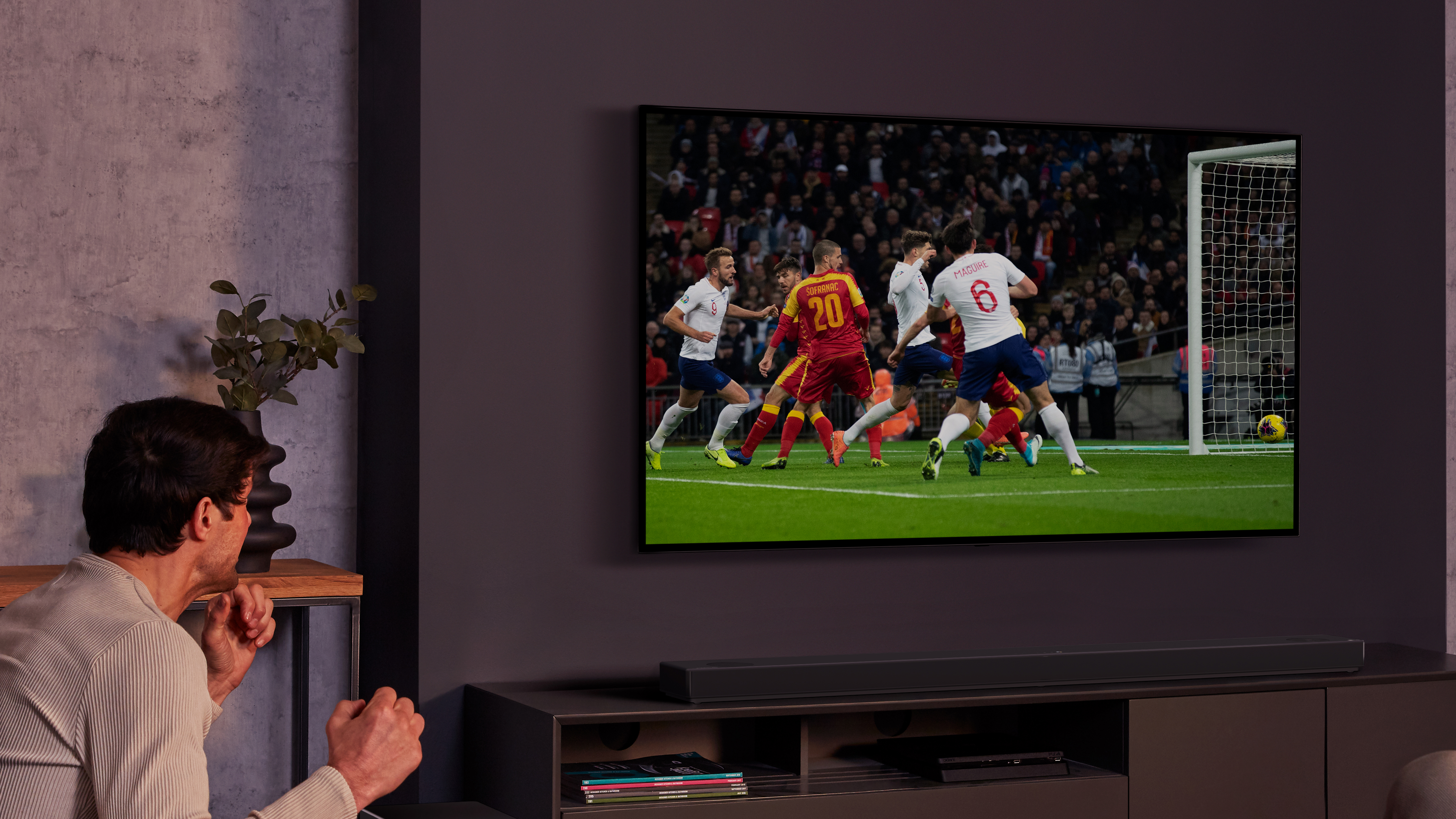
Hunting for one of the best gaming TVs? The competition between the LG CX vs Sony XH90 (UK) / X900H (US) is fierce because both will deliver top quality 4K 120fps gaming and both will look stunning across all of your favourite TV shows and movies.
The LG CX is an obvious contender for those seeking one of the best OLED TVs with high framerate support, you'll get seriously silky-smooth graphics for your next-gen consoles including the PlayStation 5 and Xbox Series X. With the latest iteration of the brand’s Gen 3 Alpha 9 picture processor, and the might of webOS, it’s no AV lightweight either.
In comparison, the Sony X90H/X900H sports LED LCD screen tech with similar HDMI 2.1 functionality, a full array backlight for better HDR, and Sony’s oft-lauded image processing.
It's clear that both are among the best TVs you can buy, but to figure out which is the better choice for you, here's how they stack up against each other.
LG CX OLED vs Sony XH90/X900H: Price

The LG CX.
When it comes to value for money, Sony’s XH90/X900H line-up is significantly cheaper than the LG CX. The CX comes with a wider range of screen sizes, although that doesn’t translate to retail savings.
The LG CX is available in 48-, 55-, 65-, and 77-inch screen sizes (OLED48CX, OLED55CX, OLED65CX and OLED77CX), priced at £1,400, £1,400, £1,900, and £4,000 respectively.
In the US, the LG CX range covers 55-, 65- and 77-inch models, which sell for US$1999, US$2,500 and US$ 3,300.
Get all the latest news, reviews, deals and buying guides on gorgeous tech, home and active products from the T3 experts
In Australia, the LG CX line-up consists of 48-, 55-, 65-, and 77-inch screen sizes, priced at AUS$2,799, AUS$3,959, AUS$£5,399, and AUS$10,199 respectively.
Of course, there are regular discounts on these – here are the current lowest prices.
Sony’s XH90 models come in 55-, 65-, 75- and 85-inch screen sizes (KD-55XH9005, KD-65XH9005, KD-75XH9005,KD-85XH9005), and are officially priced at £1,149, £1299, £1899 and £2799 respectively. In Australia, the same line sells for AUS$1695, AUS$2495, AUS$3495, and AUS$4995.
In the US, where the set is known as the X900H, it covers the same screen sizes (XBR-55X900H, XBR-65X900H, XBR-75X900H, XBR-85X900H) with prices running US$1,000, US$1,400, US$2000, US$2600.
There are usually even better regular discounts on this model than the CX – it can be had for real bargain prices.
LG CX OLED vs Sony XH90/X900H: Design and connectivity

The Sony XH90, and its slim build.
Both these flatscreens have serious appeal. Design-wise, the LG CX looks much like LG’s previous OLED screens. It’s well made, with a slim bezel and wide, centralised pedestal stand. As is the way with OLED, the panel itself is razor thin, bulging out only to accommodate electronics and connectivity.
On that front, it includes four HDMIs, a trio of USBs, an optical digital output and Ethernet to support Wi-Fi and Bluetooth.
Significantly, all HDMIs are v2.1, which means you get 4K 120fps support, ALLM (Auto Low Latency Mode) and VRR (Variable Refresh Rate). There’s also eARC, for lossless audio via the TV. The CX is also G-Sync and AMD FreeSync compatible for PC gaming.
The Sony isn’t quite so well endowed, but it's really strong for the price. It also has four HDMI inputs, one with eARC, but only two of the HDMI inputs are 4K 120fps ready. Variable Refresh Rate and Auto Low Latency compliance are not there yet, but are promised to be added via an imminent update. There’s also two USBs, Ethernet, a digital optical output, Wi-Fi and Bluetooth.
Sony XH90 vs LG CX: Picture and sound performance

The LG CX.
The CX OLED is a cracking performer. LG’s Gen 3 Alpha 9 processor introduces a raft of smart AI functionality achieved through Deep Learning, which boils down to an AI Picture Pro mode and accompanying AI Sound Pro modes. Both take the heavy lifting in terms of optimising performance, so you don’t have to worry about it.
HDR coverage includes regular HDR10, Dolby Vision IQ and HLG. The CX also supports the UHD Alliance’s Filmmaker Mode.
The Sony XH90/X900H trails the LG in terms of image processing, relying as it does on the somewhat dated X1 processor, so there are no AI picture smarts here. That said, the TV does boast Sony 4K X-Reality PRO image processing and Object-based HDR remastering, which comes into its own when it comes to giving SDR content an HDR-style lift.
There’s not an enormous difference between the two sets when it comes to HDR peak brightness, although the LG’s ability to deliver perfect blacks translates to a definite dynamic advantage advantage overall for HDR. Still, Sony’s Full Array backlight offers reasonably precise peak highlight management.
Then there’s the thorny issue of burn-in. Image retention on OLED is a cause of anxiety for gamers. While the LG employs various techniques to combat this, including screen shifting and a pixel refresher, we’d still advise diligence to minimise static image placement – regular gamers have nothing to fear, but if you're someone who spends 10 hours in Elite Dangerous at a time, OLED may not be the best option.
The Sony, which uses an LCD panel, does not suffer from image burn, and as such might be construed as more gamer friendly.
When it comes to audio, the XH90/X900H powers ahead. Sony’s Acoustic Multi Audio system, featured on the 65-inch model up, offers a veritable wall of sound, courtesy of downward firing drivers and bonus tweeters up top. Power output is 20W. You won’t feel the need for a soundbar.
The CX’s audio is more routine. Stereophonic, with a fairly hefty 40W output, it does its job, but you’ll soon hanker for an upgrade.
Both screens are able to decode Dolby Atmos, and pour it out over eARC HDMI to a compatible soundbar.
When it comes to gaming performance, there’s precious little in it. The LG, in Game mode, comes in at 13ms, while Sony’s dedicated gaming mode delivers an input lag of 15ms (both 1080/60).
LG CX OLED vs Sony XH90/X900H: Smart platform

The LG CX offers a great range of streaming services.
The LG CX represents the last time we’ll see webOS in its current form, as the brand shifts from launcher bar for full screen interface on 2021 models. We’re already lamenting the change.
The Launcher bar provides an intuitive way to navigate with the accompanying Magic remote control, and there’s a fine selection of streaming apps on board, including big hitters like Amazon Prime Video, Netflix, Apple TV+ and Disney TV+.
The catch for UK buyers, though, is that there’s no Freeview Play in the UK, which means the set is missing many mainstream TV catch-up players.
The Sony XH90 is also missing Freeview Play, but at least compensates with YouView, which serves much the same purpose.
The Sony runs Android 9.0, which offers a comparable level of premium streaming apps to webOS. It’s also Chromecast-able.
LG CX OLED vs Sony XH90/X900H: Verdict
These Sony and LG TVs may be from very different cloth, but they have comparable appeal. As befits the LG’s higher price point, and OLED technology, the CX has the edge in picture performance. It’s images are more accurate and dynamic, and if you’re a movie fan this gives it the edge.
However the Sony is no slouch. It offers naturalistic processing, with excellent upscaling, and unlike the LG, isn’t at risk from image retention when gaming.
The LG steals a march with superior connectivity, but the tables turn when it comes to smart functionality and audio. The Sony XH90 also pips the LG CX for value. Both are excellent buys, so if you want to keep the budget a bit lower, go for the Sony; if all-out image quality is your focus, it's the LG.
For over 25 years, Steve has been casting his keen eyes and ears over the best that the world of TV and audio has to offer. He was the creator of Home Cinema Choice magazine, and contributes to huge range of technology, home and music titles along with T3, including TechRadar, Louder, Ideal Home, the i newspaper, and more.

